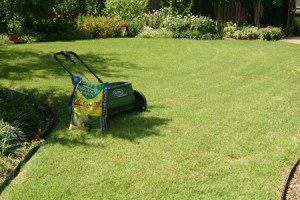
The best place to apply granular or liquid insecticides is on a healthy lawn, mulch or foliage. Sweep any excess product back into the lawn or the original container for later use.
Ten years ago the most common lawn and garden insecticides for consumers contained the active ingredients diazinon and chlorpyrifos (Dursban). These insecticides were popular because of their relatively quick kill, effectiveness against a wide range of pests, and ability to keep killing for several days to weeks or months. Today those older products have been completely replaced with a group of insecticides known as pyrethroids.
Pyrethroids were judged to be safer both to people and the environment, however recent research has turned up some problems with pyrethroid use that gardeners should be aware of. New studies have shown that pyrethroid insecticides, which are not very water soluble–but do stick very tightly to soil, are increasingly being found in the sediments of urban creeks and streams. Though not directly toxic to fish, these residues have been shown to be toxic to some invertebrate animals that live in stream bottoms. This is an ecological concern because these benthic invertebrates form the base of the food chain in streams. Kill the little critters at the bottom of the food chain and life all the way up to fish and wading birds are affected.
No one really knows for sure who is applying these insecticides that are ending up in streams, but we do know that any time pyrethroids are applied to impervious surfaces (sidewalks, driveways, the siding of homes and even bare soil, the chance of rainwater washing these pesticides attached to soil or dust is much higher. For this reason, the Environmental Protection Agency is requiring new changes in the labels of professional and consumer packages of pyrethroids.
Much of the new wording on Pyrethroid Labels will be found in the sections on “Environmental Hazards Statements” and general “Directions for Use”, and they replace current wording with stronger wording to users of the products to avoid any application that would allow that product to move off of the intended site of use. One of the most common forms of misapplication by home users is likely applying pyrethroid granular products to sidewalks and driveways, or bare soil, where they can be washed into storm drains.
Using a pesticide is not necessarily bad for the environment, but it does require a few additional precautions:
- Sweep up excess granular insecticides from sidewalks, curbs and driveways. Dispose of the granules on soil with vegetation or mulch; or if labeled for such use, apply to a pesky fire ant mound.
- Don’t apply insecticides to bare soil, especially before expected rain, as this increases the chance of contaminated soil eroding into streams where it is not wanted.
- Water-in insecticide applications made to soil immediately. This is the most effective, and environmentally sound, way to apply granular or spray products for fire ants, white grubs and other soil pests.
- Avoid mixing or disposing of insecticide near a storm drain or curb gutter, and never pour excess insecticide into a sink or storm drain. This is one of the surest ways for a pesticide to get into natural waterways. Pesticides are not easily removed from waste water, and storm drains empty directly into our rivers and lakes.
- Maintain an untreated buffer of 10 feet or more around streams and ponds when using liquid or granular insecticides.
- Always follow label directions carefully. The label is not merely a set of guidelines for use, it’s a legally binding document. Using more than the label directs, or using a pesticide in any manner not specified on the label, is a violation of federal law.